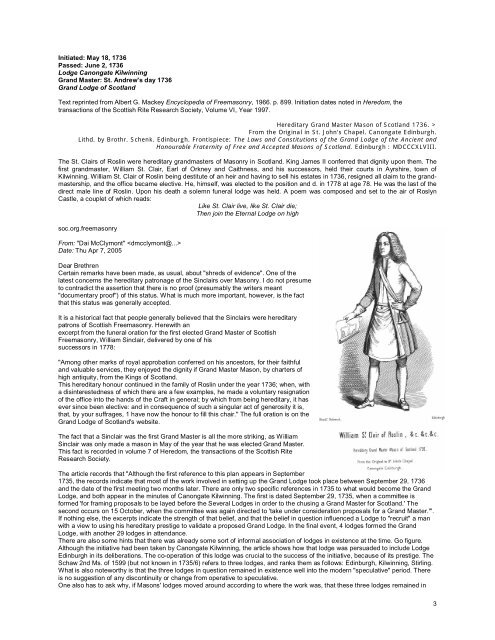Grand Masters of Scotland - Onondaga and Oswego Masonic ...
Grand Masters of Scotland - Onondaga and Oswego Masonic ...
Grand Masters of Scotland - Onondaga and Oswego Masonic ...
Create successful ePaper yourself
Turn your PDF publications into a flip-book with our unique Google optimized e-Paper software.
Initiated: May 18, 1736<br />
Passed: June 2, 1736<br />
Lodge Canongate Kilwinning<br />
<strong>Gr<strong>and</strong></strong> Master: St. Andrew's day 1736<br />
<strong>Gr<strong>and</strong></strong> Lodge <strong>of</strong> <strong>Scotl<strong>and</strong></strong><br />
Text reprinted from Albert G. Mackey Encyclopedia <strong>of</strong> Freemasonry, 1966. p. 899. Initiation dates noted in Heredom, the<br />
transactions <strong>of</strong> the Scottish Rite Research Society, Volume VI, Year 1997.<br />
Hereditary <strong>Gr<strong>and</strong></strong> Master Mason <strong>of</strong> <strong>Scotl<strong>and</strong></strong> 1736. ><br />
From the Original in St. John's Chapel. Canongate Edinburgh.<br />
Lithd. by Brothr. Schenk. Edinburgh. Frontispiece: The Laws <strong>and</strong> Constitutions <strong>of</strong> the <strong>Gr<strong>and</strong></strong> Lodge <strong>of</strong> the Ancient <strong>and</strong><br />
Honourable Fraternity <strong>of</strong> Free <strong>and</strong> Accepted Masons <strong>of</strong> <strong>Scotl<strong>and</strong></strong>. Edinburgh : MDCCCXLVIII.<br />
The St. Clairs <strong>of</strong> Roslin were hereditary gr<strong>and</strong>masters <strong>of</strong> Masonry in <strong>Scotl<strong>and</strong></strong>. King James II conferred that dignity upon them. The<br />
first gr<strong>and</strong>master, William St. Clair, Earl <strong>of</strong> Orkney <strong>and</strong> Caithness, <strong>and</strong> his successors, held their courts in Ayrshire, town <strong>of</strong><br />
Kilwinning. William St. Clair <strong>of</strong> Roslin being destitute <strong>of</strong> an heir <strong>and</strong> having to sell his estates in 1736, resigned all claim to the gr<strong>and</strong>mastership,<br />
<strong>and</strong> the <strong>of</strong>fice became elective. He, himself, was elected to the position <strong>and</strong> d. in 1778 at age 78. He was the last <strong>of</strong> the<br />
direct male line <strong>of</strong> Roslin. Upon his death a solemn funeral lodge was held. A poem was composed <strong>and</strong> set to the air <strong>of</strong> Roslyn<br />
Castle, a couplet <strong>of</strong> which reads:<br />
Like St. Clair live, like St. Clair die;<br />
Then join the Eternal Lodge on high<br />
soc.org.freemasonry<br />
From: "Dai McClymont" <br />
Date: Thu Apr 7, 2005<br />
Dear Brethren<br />
Certain remarks have been made, as usual, about "shreds <strong>of</strong> evidence". One <strong>of</strong> the<br />
latest concerns the hereditary patronage <strong>of</strong> the Sinclairs over Masonry. I do not presume<br />
to contradict the assertion that there is no pro<strong>of</strong> (presumably the writers meant<br />
"documentary pro<strong>of</strong>") <strong>of</strong> this status. What is much more important, however, is the fact<br />
that this status was generally accepted.<br />
It is a historical fact that people generally believed that the Sinclairs were hereditary<br />
patrons <strong>of</strong> Scottish Freemasonry. Herewith an<br />
excerpt from the funeral oration for the first elected <strong>Gr<strong>and</strong></strong> Master <strong>of</strong> Scottish<br />
Freemasonry, William Sinclair, delivered by one <strong>of</strong> his<br />
successors in 1778:<br />
"Among other marks <strong>of</strong> royal approbation conferred on his ancestors, for their faithful<br />
<strong>and</strong> valuable services, they enjoyed the dignity if <strong>Gr<strong>and</strong></strong> Master Mason, by charters <strong>of</strong><br />
high antiquity, from the Kings <strong>of</strong> <strong>Scotl<strong>and</strong></strong>.<br />
This hereditary honour continued in the family <strong>of</strong> Roslin under the year 1736; when, with<br />
a disinterestedness <strong>of</strong> which there are a few examples, he made a voluntary resignation<br />
<strong>of</strong> the <strong>of</strong>fice into the h<strong>and</strong>s <strong>of</strong> the Craft in general; by which from being hereditary, it has<br />
ever since been elective: <strong>and</strong> in consequence <strong>of</strong> such a singular act <strong>of</strong> generosity it is,<br />
that, by your suffrages, 1 have now the honour to fill this chair." The full oration is on the<br />
<strong>Gr<strong>and</strong></strong> Lodge <strong>of</strong> <strong>Scotl<strong>and</strong></strong>'s website.<br />
The fact that a Sinclair was the first <strong>Gr<strong>and</strong></strong> Master is all the more striking, as William<br />
Sinclair was only made a mason in May <strong>of</strong> the year that he was elected <strong>Gr<strong>and</strong></strong> Master.<br />
This fact is recorded in volume 7 <strong>of</strong> Heredom, the transactions <strong>of</strong> the Scottish Rite<br />
Research Society.<br />
The article records that "Although the first reference to this plan appears in September<br />
1735, the records indicate that most <strong>of</strong> the work involved in setting up the <strong>Gr<strong>and</strong></strong> Lodge took place between September 29, 1736<br />
<strong>and</strong> the date <strong>of</strong> the first meeting two months later. There are only two specific references in 1735 to what would become the <strong>Gr<strong>and</strong></strong><br />
Lodge, <strong>and</strong> both appear in the minutes <strong>of</strong> Canongate Kilwinning. The first is dated September 29, 1735, when a committee is<br />
formed 'for framing proposals to be layed before the Several Lodges in order to the chusing a <strong>Gr<strong>and</strong></strong> Master for <strong>Scotl<strong>and</strong></strong>.' The<br />
second occurs on 15 October, when the committee was again directed to 'take under consideration proposals for a <strong>Gr<strong>and</strong></strong> Master.'".<br />
If nothing else, the excerpts indicate the strength <strong>of</strong> that belief, <strong>and</strong> that the belief in question influenced a Lodge to "recruit" a man<br />
with a view to using his hereditary prestige to validate a proposed <strong>Gr<strong>and</strong></strong> Lodge. In the final event, 4 lodges formed the <strong>Gr<strong>and</strong></strong><br />
Lodge, with another 29 lodges in attendance.<br />
There are also some hints that there was already some sort <strong>of</strong> informal association <strong>of</strong> lodges in existence at the time. Go figure.<br />
Although the initiative had been taken by Canongate Kilwinning, the article shows how that lodge was persuaded to include Lodge<br />
Edinburgh in its deliberations. The co-operation <strong>of</strong> this lodge was crucial to the success <strong>of</strong> the initiative, because <strong>of</strong> its prestige. The<br />
Schaw 2nd Ms. <strong>of</strong> 1599 (but not known in 1735/6) refers to three lodges, <strong>and</strong> ranks them as follows: Edinburgh, Kilwinning, Stirling.<br />
What is also noteworthy is that the three lodges in question remained in existence well into the modern "speculative" period. There<br />
is no suggestion <strong>of</strong> any discontinuity or change from operative to speculative.<br />
One also has to ask why, if Masons' lodges moved around according to where the work was, that these three lodges remained in<br />
3







![Richard [Nicholls] Harison / Harrison - Onondaga and Oswego ...](https://img.yumpu.com/24950065/1/190x245/richard-nicholls-harison-harrison-onondaga-and-oswego-.jpg?quality=85)
![Richard [Nicholls] Harison / Harrison - Onondaga and Oswego ...](https://img.yumpu.com/24950063/1/190x245/richard-nicholls-harison-harrison-onondaga-and-oswego-.jpg?quality=85)








